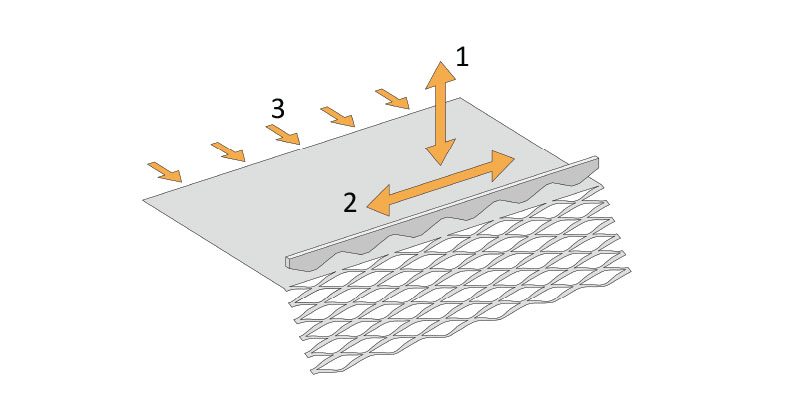Downloads
DOI:
https://doi.org/10.7480/jfde.2020.1.4698Keywords:
expanded metal, daylight transmittance, solar shading, bidirectional scattering distribution functions, angular selective shading systemsAbstract
Due to the substantial need for energy efficiency, the daylight performance of building envelopes is a key issue in sustainable architecture. A frequently used shading system consists on static expanded metal meshes (EM). As a very prominent textural facade element, expanded metal is widely used as both a cladding and static shading device.
One first aim is to provide a sufficient description of EM, including fabrication, possible usage and overall properties. This includes a set of parameters needed to control accurately the complex geometry of EM. Those parameters are also useful to get reliable 3-D computer models of EM.
The main objective of this paper is to assess, describe and compare EM light transmittance performance as a shading device. We were specifically looking to determine the influence of parameters such as geometry, colour, position and direction of incoming light on the shading performance.
The research is based on BSDF simulations via Radiance and experimental data provided at a previous laboratory stage. We have simulated and compared the performance of various EM shading devices for a south exposed façade in Madrid in most characteristic times of the year: solstices and equinoxes, as well as midday transmittance throughout the year.
How to Cite
Published
Issue
Section
License

This work is licensed under a Creative Commons Attribution 4.0 International License.
Authors or their institutions retain copyright to their publications without restrictions.
References
Alatawneh, B.M.K., Nobile, M.R., Germanà, M.L., & Reffat, R.M. (2016). THE PERFORATED BUILDING’S ENVELOPE: GUIDING THE EARLY DESIGN PHASES. 317.
Begemann, S. H. A., van den Beld, G. J., & Tenner, A. D. (1997). Daylight, Artificial Light and People in an Office Environment, Overview of Visual and Biological Responses. International Journal of Industrial Ergonomics 20(3):231–39.
Brzezicki, M. (2012). The influence of reflected solar glare caused by the glass cladding of a building: application of caustic curve analysis. Computer‐Aided Civil and Infrastructure Engineering, 27(5), 347-357.
Curic Studio. n.d. ‘Curic Sun | SketchUp Extension Warehouse’. Retrieved 21 May 2020 (https://extensions.sketchup.com/extension/49b56362-ada6-4bde-8213-8c68eb7763d1/curic-sun).
De Michele, G., Loonen, R., Saini, H., Favoino, F., Avesani, S., Papaiz, L., & Gasparella, A. (2018). Opportunities and challenges for performance prediction of dynamic Complex Fenestration Systems (CFS). Journal of Façade Design and Engineering, 6(3), 101-115.
Fernandes, L. L., Lee, E.S., McNeil, A., Jonsson, J.C., Nouidui, T., Pang, X., & Hoffmann, S. (2015). Angular Selective Window Systems: Assessment of Technical Potential for Energy Savings. Energy and Buildings 90:188–206.
Klems, J. H. (1994). New Method for Predicting the Solar Heat Gain of Complex Fenestration Systems- 2. Detailed Description of the Matrix Layer Calculation. ASHRAE Transactions 100(1):1073–1086.
Littlefair, P. (2001). Daylight, Sunlight and Solar Gain in the Urban Environment. Solar Energy 70(3):177–85.
Loonen, R.C.G.M, Rico-Martinez, J. M., Favoino, F., Brzezicki, M., Menezo, C., La Ferla, G., & Aelenei, L. (2015). Design for Façade Adaptability–Towards a Unified and Systematic Characterization. Pp. 1274–84 in Proc. 10th Energy Forum-Advanced Building Skins, Bern, Switzerland.
McNeil, A., Jonsson, C. J., Appelfeld, D., Ward, G., & Lee, E. S. (2013). A Validation of a Ray-Tracing Tool Used to Generate Bi-Directional Scattering Distribution Functions for Complex Fenestration Systems. Solar Energy 98:404–14.
McNeil, A., Jonsson, J., & Appelfeld, D. (2011). Validation of GenBSDF. 10th International Radiance Workshop.
Michele, De., G., Loonen, R., Saini, H., Favoino, F., Avesani, S., Papaiz, L., & Gasparella, A. (2018). Opportunities and Challenges for Performance Prediction of Dynamic Complex Fenestration Systems (CFS)’. Journal of Facade Design and Engineering 6(3):101–15.
Nicodemus, F. E. (1965). ‘Directional Reflectance and Emissivity of an Opaque Surface’. Applied Optics 4(7):767–773.
Perry, M. J. (1990). Mechanisms of Discomfort Glare. Lighting Research & Technology 22(3):159–159.
Rico-Martinez, J. M. (2015). Methods and Tools for the Assessment of Daylight Transmittance through Expanded Metal Meshes. University of the Basque Country, Donostia-San Sebastian.
Robbins, C. L. (1985). Daylighting. Design and Analysis.
Sadeghipour Roudsari, Mostapha. (n.d). ‘Ladybug Tools | Ladybug’. Ladybug. Retrieved 21 May 2020 https://www.ladybug.tools/ladybug.html.
Saini, H., Loonen, R. C. G. M, & Hensen, J.L.M. (2018). Simulation-Based Performance Prediction of an Energy-Harvesting Façade System with Selective Daylight Transmission. Pp. 213–19 in VIII International Congress on Architectural Envelopes.
Ward, G., Mistrick, R., Lee, E. S., McNeil, A., & Jonsson, J. (2011). Simulating the Daylight Performance of Complex Fenestration Systems Using Bidirectional Scattering Distribution Functions within Radiance. LEUKOS 7(4):241–61.
Ward, G., Kurt, M., & Bonneel, N. (2012). A Practical Framework for Sharing and Rendering Real-World Bidirectional Scattering Distribution Functions. LBNL--5954E, 1172245.
